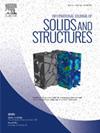Rubber-to-glass adhesion between a rigid sphere and a shape memory polymer substrate of finite thickness
IF 3.4
3区 工程技术
Q1 MECHANICS
International Journal of Solids and Structures
Pub Date : 2025-05-02
DOI:10.1016/j.ijsolstr.2025.113431
引用次数: 0
Abstract
Shape memory polymers (SMPs) are emerging as innovative smart adhesive materials with broad application potential. Compared to conventional elastomeric adhesives, SMP adhesives are distinguished by the so-called rubber-to-glass (R2G) adhesion, which involves contact in the rubbery state followed by detachment in the glassy state. This process, through a shape-locking effect, enhances adhesion strength by more than an order of magnitude compared to conventional adhesive contact. Here, we investigate the fundamental problem of a rigid sphere undergoing R2G adhesion with an SMP substrate of finite thickness through experiments, finite element (FE) simulations, and theoretical modeling. It is demonstrated that during press-in, the contact problem can be modeled as a rigid oblate spheroid contacting an infinite substrate, while the pull-off process can be described by a modified ball-and-socket model. These equivalent models yield practically useful analytical solutions for the contact radius during press-in and the R2G adhesion force during pull-off. A critical thickness-to-contact-radius ratio of around 5 is identified, below which the thickness effect becomes significant. These insights provide valuable guidance for the design and application of SMP-based smart adhesives.
刚性球体与有限厚度的形状记忆聚合物基板之间的橡胶与玻璃的粘附
形状记忆聚合物(SMPs)是一种具有广泛应用潜力的新型智能粘接材料。与传统的弹性体胶粘剂相比,SMP胶粘剂的特点是所谓的橡胶与玻璃(R2G)粘合,即在橡胶状态下接触,然后在玻璃状态下脱离。这一过程,通过形状锁定效应,提高粘接强度超过一个数量级相比,传统的胶粘剂接触。在这里,我们通过实验、有限元模拟和理论建模来研究刚性球体与有限厚度的SMP衬底进行R2G粘附的基本问题。结果表明,在压入过程中,接触问题可以被描述为一个刚性的扁球体与无限基板的接触,而拉脱过程可以用一个改进的球窝模型来描述。这些等效模型为压入过程中的接触半径和拉脱过程中的R2G附合力提供了实用的解析解。确定了厚度与接触半径的临界比约为5,低于此值,厚度效应变得显著。这些见解为基于smp的智能粘合剂的设计和应用提供了有价值的指导。
本文章由计算机程序翻译,如有差异,请以英文原文为准。
求助全文
约1分钟内获得全文
求助全文
来源期刊
CiteScore
6.70
自引率
8.30%
发文量
405
审稿时长
70 days
期刊介绍:
The International Journal of Solids and Structures has as its objective the publication and dissemination of original research in Mechanics of Solids and Structures as a field of Applied Science and Engineering. It fosters thus the exchange of ideas among workers in different parts of the world and also among workers who emphasize different aspects of the foundations and applications of the field.
Standing as it does at the cross-roads of Materials Science, Life Sciences, Mathematics, Physics and Engineering Design, the Mechanics of Solids and Structures is experiencing considerable growth as a result of recent technological advances. The Journal, by providing an international medium of communication, is encouraging this growth and is encompassing all aspects of the field from the more classical problems of structural analysis to mechanics of solids continually interacting with other media and including fracture, flow, wave propagation, heat transfer, thermal effects in solids, optimum design methods, model analysis, structural topology and numerical techniques. Interest extends to both inorganic and organic solids and structures.

 求助内容:
求助内容: 应助结果提醒方式:
应助结果提醒方式:


